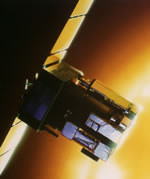
Image credit: ESA/NASA
ESA/NASA’s SOHO spacecraft is back to full capacity after a 9-day long blackout. On June 19, the pointing mechanism on the spacecraft’s high-gain antenna malfunctioned; however, controllers were able to retrieve data through its low-gain antenna using larger receiving dishes on Earth. The spacecraft was repositioned this week to let its antenna point directly at Earth. By repositioning it every three months, mission controllers don’t expect they will lose more than a fraction of data, allowing the spacecraft to continue operations for another five years.
ESA/NASA’s solar watchdog, SOHO, is back to full operation after its predicted 9-day-long high-gain antenna blackout. Engineers and scientists are now confident that they understand the situation and can work around it in the future to minimise the data losses.
Since 19 June 2003, SOHO’s high-gain antenna (HGA), which transmits high-speed data to Earth, has been fixed in position following the discovery of a malfunction in its pointing mechanism. This resulted in a loss of signal through SOHO’s usual 26-metre ground stations on 27 June 2003. However, 34-metre radio dishes continued to receive high-speed transmissions from the HGA until 1 July 2003.
Since then, astronomers have been relying primarily on a slower transmission rate signal, sent through SOHO’s backup antenna. It can be picked up whenever a 34-metre dish is available. However, this signal could not transmit all of SOHO’s data. Some data was recorded on board, however, and downloaded using high-speed transmissions through the backup antenna when time on the largest, 70-metre dishes could be spared.
SOHO itself orbits a point in space, 1.5 million kilometres closer to the Sun than the Earth, once every 6 months. To reorient the HGA for the next half of this orbit, engineers rolled the spacecraft through a half-circle on 8 July 2003. On 10 July, the 34-metre radio dish in Madrid re-established contact with SOHO’s HGA. Then on the morning of 14 July 2003, normal operations with the spacecraft resumed through its usual 26-metre ground stations, as predicted.
With the HGA now static, the blackouts, lasting between 9 and 16 days, will continue to occur every 3 months. Engineers will rotate SOHO by 180 degrees every time this occurs. This manoeuvre will minimise data losses. Stein Haugan, acting SOHO project scientist, says “It is good to welcome SOHO back to normal operations, as it proves that we have a good understanding of the situation and can confidently work around it.”
Original Source: ESA News Release
